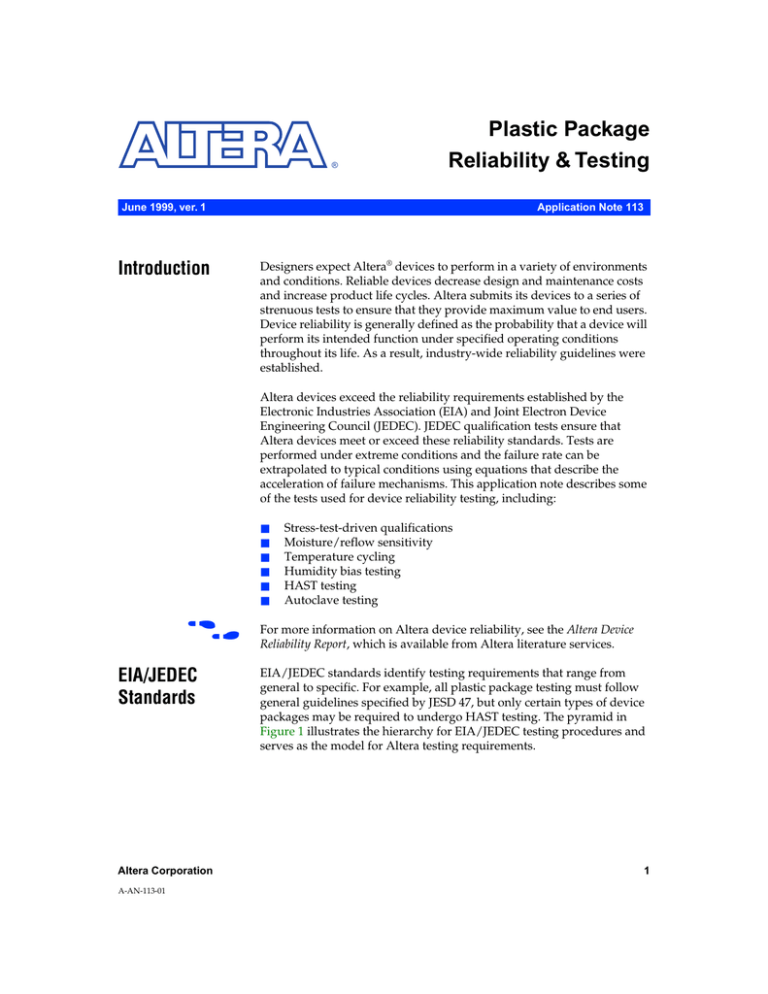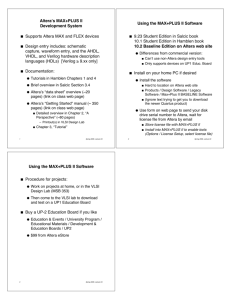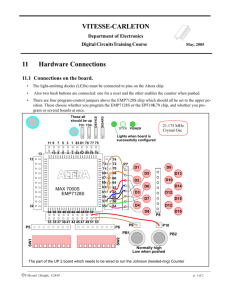
®
Plastic Package
Reliability & Testing
June 1999, ver. 1
Introduction
Application Note 113
Designers expect Altera® devices to perform in a variety of environments
and conditions. Reliable devices decrease design and maintenance costs
and increase product life cycles. Altera submits its devices to a series of
strenuous tests to ensure that they provide maximum value to end users.
Device reliability is generally defined as the probability that a device will
perform its intended function under specified operating conditions
throughout its life. As a result, industry-wide reliability guidelines were
established.
Altera devices exceed the reliability requirements established by the
Electronic Industries Association (EIA) and Joint Electron Device
Engineering Council (JEDEC). JEDEC qualification tests ensure that
Altera devices meet or exceed these reliability standards. Tests are
performed under extreme conditions and the failure rate can be
extrapolated to typical conditions using equations that describe the
acceleration of failure mechanisms. This application note describes some
of the tests used for device reliability testing, including:
■
■
■
■
■
■
f
EIA/JEDEC
Standards
Altera Corporation
A-AN-113-01
Stress-test-driven qualifications
Moisture/reflow sensitivity
Temperature cycling
Humidity bias testing
HAST testing
Autoclave testing
For more information on Altera device reliability, see the Altera Device
Reliability Report, which is available from Altera literature services.
EIA/JEDEC standards identify testing requirements that range from
general to specific. For example, all plastic package testing must follow
general guidelines specified by JESD 47, but only certain types of device
packages may be required to undergo HAST testing. The pyramid in
Figure 1 illustrates the hierarchy for EIA/JEDEC testing procedures and
serves as the model for Altera testing requirements.
1
AN 113: Plastic Package Reliability & Testing
Figure 1. EIA/JEDEC Testing Hierarchy
General
Guidelines
JESD 47
Stress-Test-Driven
Qualification
of Integrated Circuits
J-STD-020A
Moisture/Reflow Sensitivity
Classification for Non-Hermetic
Solid State Surface Mount Devices
Specific Testing
Requirements
JESD22-A104-A
Temperature
Cycling
JESD22A-101-B
Steady State
Temperature
Humidity Bias
Life Test
JESD22-A110-A
HAST Testing
JESD22-A102-B
Accelerated Moisture
Resistance —
Unbiased Autoclave
As new technologies are developed, Altera engineers rely on the
EIA/JEDEC testing hierarchy to qualify new semiconductor
architectures. New architectures may include smaller process geometries,
an increased number of die layers, increased gate and I/O pin counts,
decreased voltage levels, and changes in package material composition.
These design changes affect the reliability of a device. As a result, the
device may require a different set of tests as technologies advance.
The Stress-Test-Driven Qualification of Integrated Circuits (JEDEC
Std. 47) guideline determines which tests a new design must undergo and
helps product engineers identify and correct flaws that may arise. The
guideline also identifies sample size requirements and testing
qualifications for new devices to help expose process flaws.
f
Moisture/
Reflow
Sensitivity
2
For more information on EIA/JEDEC standards, visit the JEDEC web site
at http://www.jedec.org.
Altera uses moisture/reflow sensitivity testing (J-STD-020A) guidelines
to inform customers of device sensitivity to moisture-induced stress. After
testing, devices are assigned sensitivity levels. These classification levels
are useful in determining the proper storage and handling of Altera
devices to prevent thermal and mechanical damage during solder reflow
or repair. Moisture sensitivity levels determine the length of time a device
can be exposed to humidity. See Table 1.
Altera Corporation
AN 113: Plastic Package Reliability & Testing
Table 1. Moisture Sensitivity Levels
Floor Life
Level
Soaking Requirements
Time
Conditions (1)
Time (Hours)
Conditions (1)
1
Unlimited
≤30 ˚C/85%
168
85 ˚C/85%
2
1 Year
≤30 ˚C/60%
168
85 ˚C/60%
2a
4 Weeks
≤30 ˚C/60%
672
30 ˚C/60%
3
168 Hours
≤30 ˚C/60%
192
30 ˚C/60%
4
72 Hours
≤30 ˚C/60%
96
30 ˚C/60%
5
48 Hours
≤30 ˚C/60%
72
30 ˚C/60%
5a
24 Hours
≤30 ˚C/60%
48
30 ˚C/60%
6
Time On Label
≤30 ˚C/60%
Time On Label
30 ˚C/60%
Note:
(1)
Condition percentages denote relative humidity levels.
The device classification applies to all surface mount packages: ball-grid
array (BGA), small-outline integrated circuit (SOIC), plastic J-lead chip
carrier (PLCC), plastic thin quad flat pack (TQFP), plastic quad flat pack
(PQFP), and power quad flat pack (RQFP) device packages. Because of
their composition, these device packages could be damaged during solder
reflow.
The vapor pressure of moisture trapped inside of a plastic package
increases when the package is exposed to high solder reflow
temperatures. This pressure can lead to internal delamination, internal
cracks, bond damage, wire necking, bond lifting, die lifting, thin film
cracking, or cratering beneath the bonds. In extreme cases, the package
emits an audible crack, also known as the “popcorn” effect.
To minimize the chances of device damage, Altera recommends using a
100% convection reflow system that is capable of maintaining the reflow
profiles required by the J-STD-020A standard.
f
For more information on reflow soldering, see Application Note 81 (Reflow
Soldering Guidelines for Surface-Mount Devices).
Small, thin devices can reach body temperatures greater than 220 ˚C when
reflow-soldered to boards profiled for larger devices. To compensate for
this difference, some small packages have been reclassified to withstand
235 ˚C. Table 2 defines the transition thickness/volume of packages that
can reach 235 ˚C when reflow soldered to boards with larger devices.
Altera Corporation
3
AN 113: Plastic Package Reliability & Testing
Table 2. Small Device Reflow Conditions
Conditions
Package Thickness
≥ 2.5 mm & All
BGA Packages
Package Thickness
< 2.5 mm & Package
Volume ≥ 350 mm3
Package Thickness
< 2.5 mm & Package
Volume < 350 mm3
Convection Temp.
220 +5/-0 ˚C
Convection 220 +5/-0 ˚C
Convection 235 +5/-0 ˚C
VPR Peak Temp.
215-219 ˚C
215-219 ˚C
N.A. (1)
IR/Convection Temp.
220 +5/-0 ˚C
220 +5/-0 ˚C
235 +5/-0 ˚C
Package Type
All BGA, FineLine BGA
packages
All other packages
T44, Q44, T100, T32
packages
Note:
(1)
VPR phase will not exceed 219 ˚C.
For more information on moisture/reflow sensitivity classification for
plastic packages, refer to JEDEC Standard J-STD-020A.
Package reliability can also be affected by the rate at which a particular
device reaches its testing temperature. Table 3 lists classification reflow
profiles for two types of reflow convection methods: full convection and
infra-red convection.
Table 3. Classification Reflow Profiles
Condition
Average ramp-up rate (183 ˚C to peak)
Full or Infra-Red Convection (1)
1 - 3 ˚C/second
Preheat temperature 125 ˚C (± 25 ˚C)
120 seconds maximum
Temperature maintained above 183 ˚C
60 to 150 seconds
Time within 5 ˚C of actual peak
temperature
10 to 20 seconds
Peak temperature range
(2)
Ramp-down rate
6 ˚C/second maximum
Time 25 ˚C to peak temperature
6 minutes maximum
Note:
(1)
(2)
Temperature
Cycling
4
Altera recommends using the full convection method for production.
See Table 2.
Temperature cycling (JESD22-A104-A) is performed to determine the
resistance of Altera devices to high and low temperature extremes. This
environmental stress test is designed to simulate the extensive changes in
temperature to which devices and packages may be exposed. To pass the
test, devices must not show signs of damage such as cracking, chipping,
or breaking. Table 4 shows the classifications for Altera devices.
Altera Corporation
AN 113: Plastic Package Reliability & Testing
Table 4. Temperature Cycling Classifications
Classification
Low Temperature (˚C)
High Temperature (˚C)
A
–55 (+0, –10)
+85 (+0, –10)
B
–55 (+0, –10)
+125 (+0, –10)
C
–65 (+0, –10)
+150 (+0, –10)
D
–65 (+0, –10)
+200 (+0, –10)
F
–65 (+0, –10)
+175 (+0, –10)
G
–40 (+0, –10)
+125 (+0, –10)
H
–55 (+0, –10)
+150 (+0, –10)
Temperature cycling may also expose weaknesses in packages that are
composed of different materials. If device packages are composed of
different materials, expansion and contraction of the package materials
can occur at different rates when exposed to temperature extremes.
Figure 2 shows an example of the differences in the thermal coefficients of
expansion between two materials with identical lengths.
Figure 2. The Effects of Thermal Coefficient of Expansion on Two Materials
Expansion Caused by
Temperature Increase
Material 1
Individual
Material Expansion
Material 2
Material 1
Effective Expansion of
Bonded Materials
Material 2
Because the materials are in contact with each other, the actual expansion
of the two materials is a composite of the two. Both materials expand to
the same length when placed together, which places extra stress on
material 1. The materials act similarly during compression. As a result,
shear stresses can occur at the joint between the two materials, which
results in the passivation of metal layers.
Altera Corporation
5
AN 113: Plastic Package Reliability & Testing
When devices are repeatedly cycled between hot and cold temperature
extremes, the shear stress of the materials change from compressive to
tensile and back. If the temperature extremes are great enough, cracking
and/or shear displacement of the materials could occur, resulting in
displacement of the metal traces below the packaging layers. See Figure 3.
Figure 3. Passivation Cracking & Layer Displacement
Passivation
Material 2
Material 1
During this test, shear stresses are greatest at the corners of the die and are
generally greater for larger die. Cracks in packaging can run down into
the device, eventually breaking or severing metal layers or polysilicon
below the passivation layer. Displaced metal traces cause leaking current
or short circuits when metal lines are moved against other lines or power
buses. To avoid these failures, Altera extensively tests devices following
the procedure of test JESD22-A104-A.
To avoid these failures, Altera extensively tests devices following the
procedures of test JESD22-A104-A. By following the device classifications
shown in Table 4 on page 5, you can mimimize the chance of this type of
failure.
Humidity Bias
Testing
The Steady-State Temperature Humidity Bias Life Test (JESD22A-101-B)
evaluates the reliability of Altera devices in humid environments. The test
uses temperature, humidity, and electrical bias to accelerate the
penetration of moisture through device packages. The test is performed at
85 ˚C and 85% relative humidity with applied bias. This test can uncover
flaws in device package material composition or package assembly.
The test is carried out in a temperature-humidity test chamber capable of
maintaining continuous temperature and relative humidity levels. It must
also provide electrical connections to the devices under test in a specified
biasing configuration. The test is performed under extreme conditions.
The failure rate can be exrapolated to typical conditions using equations
that describe acceleration of failure mechanisms.
Altera uses two types of electrical biasing for testing: continuous bias and
cycled bias.
6
Altera Corporation
AN 113: Plastic Package Reliability & Testing
In continuous electrical bias, DC bias is applied continuously. Continuous
bias is more severe than cycled bias when die temperatures are ≤ 10 ˚C
higher than the chamber’s ambient temperature or if die temperatures are
not known when the power dissipation of the device is less than 200 mW.
If the power dissipation of the device exceeds 200 mW, you should
recalculate the die temperature (power × thermal resistance). If this
number is more than 5 ˚C than the test specification, then you should use
cycled bias. If the die temperature exceeds the chamber’s ambient
temperature by more than 5 ˚C, include the temperature difference in the
test results because acceleration of failure mechanisms will be affected.
In cycled electrical bias, DC voltage applied to the devices is interrupted
periodically with frequency and duty cycles. If biasing causes the
temperature to rise 10 ˚C above the chamber’s ambient temperature, the
cycled bias is more severe than continuous bias when optimized for a
specific device type. Heating caused by power dissipation drives
moisture away from the die and slows moisture-related failure. Cycled
bias lets moisture collect on the die during the off periods. Cycling
electrical bias with one hour on and one hour off is optimal for most
devices.
HAST Testing
Highly Accelerated Stress Testing (HAST) (JESD22-A110-A) evaluates the
reliability of Altera devices in humid environments. Like humidity bias
testing, HAST testing uses a combination of electrical bias, high
temperature, and high humidity. However, HAST testing also includes
high pressure to accelerate corrosion-type failures. The test is performed
at 130 ˚C and 85% relative humidity with applied bias. HAST testing can
uncover flaws in packaging material, seals, and joints between the
package material and pins.
The electrical bias patterns used for HAST testing are similar to the ones
used for humidity bias testing. The bias is used for powering the devices
inside a HAST chamber. Wherever possible, an alternating sequence of
VCC and ground is used so that signal pins that are biased with one
voltage are placed closest to signal pins that are biased with the opposite
voltage. For HAST testing, VCC is set to the minimal condition.
Specially designed boards are used in HAST chambers. Ordinary boards
cannot be used because of severe HAST chamber conditions. For testing,
Altera uses special polyimide printed circuit boards (PCBs) with buried
traces.
Altera Corporation
7
AN 113: Plastic Package Reliability & Testing
Autoclave Testing
Autoclave (JESD22-A102-B) testing uses a temperature/humidity
environment with no applied electrical bias to accelerate failure
caused by metallization corrosion. This test subjects devices to
saturated steam at 121 ˚C and 15 PSIG pressure. This pressure is
“gauge” pressure, and is twice the atmospheric pressure of 15 PSI.
The pressure can also be represented as two atmospheres. Autoclave
testing tests the resistance of passivation layers on the die and
exposes flaws in package design.
High pressure in autoclave testing drives water vapor through
device packages until it reaches the die surface. Bond pads and
poorly passivated metals can corrode. Several other failures can also
occur. For example, non-volatile memory—using charge storage on
floating gates (flash and EEPROM devices)— could be subject to
charge loss from the floating gates. This charge loss is caused by
moisture penetrating through passivation layers. If the moisture
reaches the floating gate, it can quickly leak the stored charge off the
floating gate. Altera uses the results of autoclave testing to minimize
device failure.
Other failure mechanisms that can be aggravated are external
package damage, shorts, or leakage paths. Improper
rinsing/cleaning following lead finish can result in contamination
migrating between the leads. This contamination causes leakage
paths. Tin and lead migration, via dendritic growth from one lead to
another, is another possible failure mechanism for autoclave testing.
Conclusion
8
To ensure a consistent level of quality, Altera subjects its plastic
packaged devices to a series of EIA/JEDEC tests. These tests are
designed to accelerate failure in devices, uncovering any process or
design flaws in Altera devices. Altera uses the results of these tests to
improve packages and minimize field failures. The information is
useful to help designers match their stress and environment
requirements and to establish guidelines for handling, soldering,
classifying, and storing Altera devices.
Altera Corporation
AN 113: Plastic Package Reliability & Testing
®
101 Innovation Drive
San Jose, CA 95134
(408) 544-7000
http://www.altera.com
Applications Hotline:
(800) 800-EPLD
Customer Marketing:
(408) 544-7104
Literature Services:
(888) 3-ALTERA
lit_req@altera.com
9
Altera is a trademark of Altera Corporation in the United States and other countries. Altera acknowledges the
trademarks of other organizations for their respective products or services mentioned in this document. Altera
products are protected under numerous U.S. and foreign patents and pending applications, maskwork rights,
and copyrights. Altera warrants performance of its semiconductor products to current specifications in
accordance with Altera’s standard warranty, but reserves the right to make changes to any products and
services at any time without notice. Altera assumes no responsibility or liability arising out
of the application or use of any information, product, or service described herein except as
expressly agreed to in writing by Altera Corporation. Altera customers are advised to
obtain the latest version of device specifications before relying on any published
information and before placing orders for products or services.
Copyright 1999 Altera Corporation. All rights reserved.
Altera Corporation
Printed on Recycled Paper.




